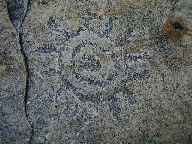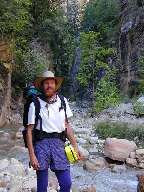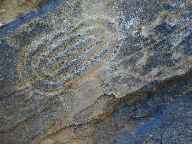




|
Tofu Jerky
1/2 cup Soy sauce
Drain then cut the tofu: “Plank” the tofu by placing it
between two
cutting boards, angled so they drain into the sink, then weight the top
board to “plank” (drain) the tofu for several hours. Then, take a 1 lb cube of
tofu, cut it in half, and then slice it into strips on its short side. Strips
should be about 4-5 mm in thickness. They may look big, but they'll
shrink to about half their size.
Mix all the marinade ingredients together well. Put the tofu
in a single
layer in a shallow baking pan or cookie sheet and pour the marinade
over it. Let soak for several hours, preferably overnight in the
refrigerator.
Drain excess liquid (and reuse!) and dry tofu in a food
dehydrator at
about 115 degrees F, or a lesser choice is in a warm (200 F) oven.
This will take probably 8 hours (drier), perhaps 4 in the oven, depending on weather.
I suggest drying it outside, because otherwise it will fill your house with strong
odors. If you live in a sunny, dry climate (Utah in the summer),
you can sun dry it outside, it'll take all day.
If you dry indoors in the winter, your house gets filled
with a wonderful (some say overpowering)
smoky smell. If you're drying in the oven, you'll need to flip the tofu
over hourly so it dries evenly. The stuff is delicious and keeps
indefinitely.
Dry the stuff until it's very chewy, but not crispy. Be
creative: Use
low-sodium soy if you want less salt (it is rather salty) Use tabasco or
ground cayenne if you want it hot. Chili powder makes chili jerky.
Oregano and basil makes pizza jerky.
Store the dried tofu jerky in an airtight container.
3 Tb To 4 Tb liquid smoke
1/8 cup Water
1 Tb Onion powder
1 tsp Garlic powder or
1 Clove crushed fresh garlic
1 Tb Fresh ground black pepper
1 tsp Honey
1 pound extra firm tofu
Serve this granola with stewed fruit, hot or cold
milk, water, mint or rose hip tea, or just plain dry as a pocket food.
1/2 c oil
Heat oil, honey, molasses in a large pot until thin.
Remove from heat. Add remaining in order given, except fruit, nuts, and
seeds. Stir well after each addition. Spread mixture onto a cookie sheet.
Bake at 250 for 1 - 2 hrs., stirring occasionally. Cool. Stir in remaining
ingredients. Store in airtight container. Makes about 1 gallon.
Note: I found that a food dryer works as well or
better than an oven. I also add more honey or molasses (by 1/2 c).
1/2 c honey
1/2 c molasses or maple syrup
1 tbl vanilla
1/4 c milk powder
2 tbl nutritional yeast
1 c wheat germ
5 c rolled oats
2 c rolled wheat
2 c rolled rye
1 c unsweetened coconut shreds
2 c raisins or currants
1 c each - cashews, almonds, pitted dates, sunflower
seeds
1 cup whole wheat flour
1 cup unsweetened coconut
1 cup brown sugar
1 cup rolled oats
˝ cup butter
2 tbls water
˝ tsp. baking soda
1 tbls molasses or honey
Combine the flour, coconut, sugar, and oats in a large bowl. Mix well. In a small saucepan melt the butter with the water, soda, and molasses. Add this to the dry ingredients, and mix well with your hands. Shape into cookies and bake on an oiled cookie sheet at 350 for about 20 minutes or until nice and brown. Cool on a rack. (As in most cookie recipes, one needs to double this batch to get much of anything.)
What is an Anzac? Well, according to those better anchored in history, the name stands for "Australian-New Zealand Army Corps." Reportedly, they were prepared by women (and some men?) during World War I, to send to the troops on the beaches of Gallipoli. Why? They are durable, and may still be fresh after an 8-week boat, or hiking, trip. Of course, after a week of hiking, Anzacs will exist in memory only. I included this recipe because you may wish to enjoy Anzacs on your next long trip....
2/3 cup couscous (hungry hiker standard = 1/3
cup/hiker - adjust ingredients as needed)
2 Tbs. Dried chives
1/2 Teaspoon Curry powder
(optional) 1/8 teaspoons Shahi Paneer Masala spice blend
1 vegetable bouillon cube
3 garlic cloves or 1/2 teaspoon garlic powder
3-4 dried tomatoes, diced - or, 1/3 cup dried vegies per person
Optional - sunflower seeds, pistachio or pine nuts, one small handfull
twice the amount water as couscous
Combine and cook for 2 minutes, let sit for 5 minutes. Grag some of those salted sunflower seeds from your lunch sack and sprinkle them on as garnish. (If you are using dried vegies - start soaking them first, and add the other ingredients when they are almost rehydrated.) Enjoy.
6-8 ounces angel hair thin spaghetti (3-4 ounces per
hiker)
2 Tbs olive oil (1 + Tb per hiker)
1 cup Parmesan cheese (1/2 cup per hiker)
4-6 tsps. Ground sweet basil
2 Tbs. Parsley flakes
garlic powder and pepper to taste
Cook and drain pasta. Add oil and toss, then mix in the remaining
ingredients.
Rob's notes: I use thin spaghetti such as angel hair
which cooks in 5 minutes.
As a general rule, I allow 3 ounces of spaghetti per person (4 ounces/person = hungry hiker
standard). One can use instant humus instead of
(or in addition to cheese) - and this seems to last better in hot weather. One can soak
some dried
tomatoes while the pasta is cooking, adding this like a garnish.
Pesto variation (a favorite!): Get one or more of
those instant pesto sauce
mixes from the store. Start cooking it first - get it bubling and set it aside (save fuel).
Cook and drain the spaghetti. Pour on some olive oil, spoon on some pesto sauce, and
sprinkle on some parmesan cheese. You can save weight by cutting the amount of cheese.
You can eliminate the parsley, garlic powder and pepper if you are using pesto sauce.
Another option is to use instant humus rather than parmensan cheese (but only if you like
this stuff!). Enjoy.
1 Lipton (or generic) side dish packet (about 5 ounces)
1 cup instant rice (can use quick brown rice)
1/4 - 1/2 tsp salt
1/2 cup (or more) unflavored TVP (Textured Vegetable Protein)
4 cups water (adjust as needed)
(optional - dried vegies of your choice - add more water as needed)
Get water boiling, add Lipton, then rice if using brown rice. Let it sit for 7-10 minutes while you enjoy the vista. Carefully (don't burn pot) return to a low boil, add rice if using instant white rice, TVP, check for saltiness (add salt if needed). Let sit a few minutes. Enjoy.
The basic meal approximate weight (for 2) is about 9-10 ounces. I used this and the next meal while hiking the JMT (John Muir Trail), partly because it (barely) fit in my 1.3 liter ultralight pot and cooked easily with my alcohol stove.
Unflavored TVP is suggested because the seasonings in the Lipton meal may contrast unpleasantly with flavored TVP. You may want to start with a soup to feel like you've had enough to eat and to rebalance your electrolytes. Personally, I really enjoy the miso, hot and sour, and other instant soups found in Chinese markets - about 0.5 ounces or less per serving, and well worth it. Add in a foil of salmon or tuna if you need more food (and have only a small pot) or protein.
1 Idahoan brand (or generic) packet instant potatoes (about 4 ounces)
1 cup (to 1 and 3/4 cups) quick cook black or pinto beans (these beans are cooked, then
rolled to a rolled oat texture, then dried - a good source of protein)
1/4 - 1/2 tsp salt (don't add unless needed)
1 cup (or more) dried peas
3 cups water (adjust as needed)
(optional - cooked then dried lentils - add more water as needed - might subsitute for peas)
Get water boiling. Set aside a cup or more of hot water. Rehydrate vegies (let them sit to rehydrate while you set up your shelter or write journal notes), bring water and vegies back to boiling if they have cooled significantly, then add potatoes, and let meal sit for 5 minutes, adding more hot water as needed. This can be an expanding proposition, so try it at home to be certain your pot is large enough. Check for saltiness (add salt if needed). Let sit a few minutes. Enjoy.
The basic meal approximate weight (for 2) is about 8-9 ounces. You may want to start with a soup to feel like you've had enough to eat and to rebalance your electrolytes. Personally, I really enjoy the miso, hot and sour, and other instant soups found in Chinese markets - about 0.5 ounces or less per serving, and well worth it.
Variation: I found a huge can of Trio instant potatoes (we called these "The exploding ones") at Costco, and found that combining rehdrated peas and flavored (ham or sausage, or ?) TVP (Textured Vegetable Protein), with the exploding ones makes a quick meal and adds to your meal diversity. Again, it's best served with a precursor of soup. Add in a foil of salmon or tuna if you need more food (and have only a small pot) or protein.
1/2 to 2/3 cup orzo (find this next to the spaghetti)
3/4 to 1 cup ground beef (freeze-dried) (I found good stuff at Honeyville Foods)
1/4 - 1/2 tsp garlic powder
1/2 cup dried peas
1 boullion cube (I use Knorr vegetable)
1 tsp parsley
2 cups water (boil 3 cups, put aside some hot water at start of cooking, adjust as needed)
Get water boiling. Set aside a cup or more of hot water. Slice or crumble the boullion into the 2 cups of hot water, followed by everything else. Return to boil, turn off stove and let sit 10 minutes. Adjust water level after about 5 minutes - you may need to add water and/or reheat. You may wish to experiment with other meats or TVP (textured vegetable protein).
6 tbls dried whole eggs
1 package egg flower soup (e.g., kikoman)
1 package Idahoan potatoes
1/2 cup dried mixed veggies
2.5 cups water (boil @ 3.5 cups, put aside some hot water at start of cooking, adjust as needed)
Get water boiling. Set aside a cup or more of hot water - the potatoes soak up a surprising amount of water. Cook eggs and soup, add potatoes. Let sit for a few minutes - add water from your reserve hot water as needed. You may wish to experiment with adding unflavored TVP for more protein (TVP = textured vegetable protein).
1 cup (dry) instant rice (produces 2 cups cooked)
1/3 cup Bear Creek Cheddar Broccoli dry soup mix (11.2 oz bag contains @ 2 cups)
1/3 cup Ham TVP - heat in sauce or pour 2/3 cup hot water and let sit while sauce
reconstitutes
Start cooking sauce. Set aside, enjoy a hot beverage,
then cook the rice. Add all together and enjoy. The sauce takes 15 minutes or more to
reconstitute, but don't bother trying to simmer it.
(use 1/2 amount of water recommended for soup - heat and set aside to reconstitute
rather than using lots of fuel)
(TVP is texturized vegatable protein -- and can be found in
some of your favorite organic food stores, and it is also produced by Walton Feed in
Montpelier, Idaho)
Ramen Noodles - 2 packages
Sun Dried Tomatoes - 1/2 c
Shelf Stable Pepperoni (mini ones are best) - 1/2 c
Italian Salad Dressing Mix - 1 pkt (not all)
String Cheese - 2 pkt
Olive Oil - 1 T
Shelf stable parmesan cheese - 1 T
Water - 3 c
Combine ramen noodles and tomatoes in a freezer bag or pot. Pour boiling water over the ramen mix. Steam or boil in pot 3-5 minutes. Dice cheese and pepperoni. Drain the water, leaving about 1 Tbsp per serving. Add in olive oil, dressing mix and stir (about 2 tsp per serving). Stir in pepperoni and cheese, toss to coat.
3/4 cup macaroni (can use 1/2 cup orzo)
1/3 cup dried ham (can be TVP) or chicken, etc.
1/3 cup dried mixed veggies
1/4 teaspoon salt (optional)
1 and 3/4 cup water
Pack cheese and milk in separate bag
2 T (tablespoon) milk powder
2 T cheddar cheese powder; or 4 T dried grated cheddar
optional for decadence: 1/2 ounce good olive oil (sprinkle on dish after cooking)
Add mac, ham, and veggies to water as it heats (to increase rehydrating time). Cook for 2-3 minutes, place pot in cozy or insulating clothing for 10+ minutes. Check mac for being done. Stir in milk and cheese.
Options include substituting other pastas, such as sea shell or orzo. You can use a variety of veggies and meats/TVPs. I suggest placing aside a reserve of hot water in the event you need more water during cooking. Enjoy.
Note about chicken - If you dry cooked chicken, it will be a problem to rehydrate unless you cook it in a pressure cooker or dry canned chicken. I'm not sure how come pressure cooking makes chicken easier to rehydrate (after drying), but it certainly does.
1/2 cup gorp/day/person
1-2, one ounce cheese stick
1/4 cup salted nuts/day/person (good option = 2 ounce bags from Costco)
1 protein bar/day/person (aim for 30 grams of protein per bar; Costco may have these)
jerky, ginger, dried mango, electrolytes if desired (jerkey can be tofu jerkey - see above)
Over the past thirty years, I first used a Svea (Bunsen burner type
stove), later a Peak, followed by an MSR XGK, then a Whisperlite International, and most
recently a Simmerlite. The XGK is a tremendous bicycle touring stove because it can burn
most anything. (See the "Border Bop" trip report about what it cost Marv and me to tour and
cook for 38 days.)
Your experience and needs may vary, but for what it is worth -
some general guidelines are:
In warm weather, after carefully packing your meals (minimal cooking, use of soaking while preparing another food course) you can pack as little as 2 ounces of white gas per person per day. This is generally what Kathleen and I can accomplish by drying our own food and using simple soups such as Knorr vegetarian bouillon cubes and instant oatmeal for breakfast. Therefore, a quart of fuel is about the minimum for two people for a 7-day adventure in warm weather using water that is not too cold. This is for desert-type hiking. We typically add a small 6 or 8 ounce bottle of gas for unexpected contingencies. You never know when that wonderful water filter might clog and you're purifying water by boiling it.
We also prime the Simmerlite (and the other stoves) with denatured alcohol. This accomplishes three important things: 1) Denatured alcohol does not "flash" when ignited, making it safer to use. 2) Using denatured alcohol helps keep the jets of the stove clean, reducing field maintenance difficulties. 3) You can carry the denatured alcohol in a 2 oz. squeeze bottle (pack carefully) and this allows you to more precisely squirt the right amount into the priming cup of the stove. A 2 ounce bottle of denatured alcohol is usually sufficient for a week or more of backpacking.
The general guideline from stove makers is 3-4 ounces (114 ml) of white gas per person per day in warm weather. The WV guideline is 2 ounces per person per day in warm weather, when you have modest cooking and hot water (coffee, tea, etc.) needs - use this as a starting point, adding more for cool weather or more complicated menus. Note that this is a starting guideline. Heating that extremely chilly Colorado River water? Consider taking a bit more fuel.
If you are melting snow (ski camping or mountaineering) you may wish to pack 8 ounces (237 ml) per person per day.
100 grams of white gas = 3.6 ounces.
28 grams = 1 ounce.
100 grams boils about 7 liters of water (not snow).
White gas has the advantage of being relatively easy to obtain in the U.S. So, if flying you may be able to bring your stove, and obtain fuel at your destination. The volume you carry is easily adjusted, and the weight decreases as you hike along - as opposed to those annoying canisters that folks leave "hidden" under rocks and such. See the informative worksheet and stove tips sites below:
Find the lightest stove - based on your situation (click here).
White gas stoves still reign as trip length and number
of hikers increases. However, a Caldera Cone alcohol stove is terrific for two and almost always
the most efficient choice for a solo hiker (and probably for a hiking pair). My default methodology
is to take the cone when one or two of us are hiking, consider a compressed (butane type- canister) gas stove for three
or short trips with a group larger than two, and divide the weight of that white gas stove (gaining increased
BTU per fuel ounce) when three or more are going long.
Your mileage may vary. Perform your own data check by tinkering with the
inputs (e.g., amount of water heated per day) in the link at the top of the above paragraph. On our last
GC trip, to Cheyava Falls, we found that our choice for a group of 5 was white gas or canister stove, yet
the cansister fuel cost a lot more and then there is dealing with the expired canisters. We took the
MSR Simmerlite (white gas). On the Transcendental Trans-Tonto (114 miles) we (two) took the Caldera Cone (see below, then
see the TTT report).
Transcendental Trans-Tonto (TTT): Tanner TH to South Bass – about 114 miles(click here).
The Concept of Cone. After
goofing with the design and redesign of building my own alcohol stove (see below), I met a couple hiking
the Hayduke Trail. We met near Deer Creek in the bottom of the Grand Canyon, and talk soon progressed to this
cone-shaped stove they were using. It was one of the Trail Designs Caldera Cones, and they
were cheerleaders for this stove. I have now owned one for over four years and can state that they
are far superior to other alcohol stoves. Yet, it is not the stove. It's the cone, funneling
the majority of heat to your pot (open to flame because there are no stand sections in the way).
The limitation is that only one pot works with the cone because the
cone supports the pot from the pot rim. The
benefits are efficiency and stability and light weight. Given proper design to allow the proper
distance between stove and pot bottom, you might combine the cone with your own stove (see below) design - or
buy the unit in a classy carrying cylinder (which doubles as cup and bowl).
Build a cone - youtube video (click here).
Build a Caldera Clone by Kevin Beeden, aka 'Captain Paranoia' of the UK (click here).
Build an Alcohol Stove.
I have been toying with building a light weight alcohol stove for
backpacking. My friend Bob G. got started first and built a very functional stove, based on
the design of the Cat (food) Stove. We became interested in alcohol stoves after finding
this comparison site:
Find the lightest stove - based on your situation (click here).
White gas stoves still reign as trip length and number
of hikers increases. However, a Caldera Cone alcohol stove is terrific for two and almost always
the most efficient choice for a solo hiker (and probably for a hiking pair). My default methodology
is to take the cone when one or two of us are hiking, consider a compressed (butane type- canister) gas stove for three
or short trips with a group larger than two, and divide the weight of that white gas stove (gaining increased
BTU per fuel ounce) when three or more are going long.
Your mileage may vary. Perform your own data check by tinkering with the
inputs (e.g., amount of water heated per day) in the link at the top of the above paragraph. On our last
GC trip, to Cheyava Falls, we found that our choice for a group of 5 was white gas or canister stove, yet
the cansister fuel cost a lot more and then there is dealing with the expired canisters. We took the
MSR Simmerlite (white gas). On the Transcendental Trans-Tonto (114 miles) we (two) took the Caldera Cone.
Transcendental Trans-Tonto (TTT): Tanner TH to South Bass – about 114 miles(click here).
Assorted information about backpacking stoves (click here).
Probably more than you thought you wanted to know.
(click here) Here are my notes about white gas backpacking stoves.
Stop the electrons! Kevin Beeden, aka 'Captain Paranoia,' from the UK, has posted
a design for a very efficient and crafty alcohol burner. This is a terrific how-to article. Here it is:
Captain Paranoia shows you how to make your very own drinks can meths stove.
(click here).
I have made his good work available here with this MS
Word file (htm file - click here - because links sometimes change and I don't want to lose this
terrific work).
Long before Kevin B. sent along the above designs, Bob G. and I built stoves
based on this design:
If you cannot locate this cat food can stove link, get this MS
Word file (htm file - click here).
Here are our modifications to the Cat Stove:
The stove in the below photos weighs 3 ounces (stove,
stand, wind screen).
Use a paper punch or drill to open 10, 1/4" holes around
the (Open end) top of the smaller can - rather than a church key (beer can opener).
This allows more room for alcohol in the stove (so it doesn't leak out the vents).
Make the stand to support the pot 1.75" above top of
can stove. Keep in mind where you are going to pack this stand - will it fit in the pot?
Make the opening in the large can 1.5" (not 1.75").
Make holes in wind screen in one 90 degree
quadrant (or 180 degree quadrant)- so the screen can be oriented away from any wind.
You can roll the screen
around most fuel cans and secure with a rubber band for travel - saves wear and tear.
In a test run, using 1.25 ounces of denatured
alcohol, it boiled 4 cups of cool water in 12 minutes.
The ambient air temperature was in the high 70Fs, and there was no wind. Altitude was 7,000'.
I doubt the stove
would have boiled the water if not for the wind screen and a tight-fitting lid on the pot.
Your stove's performance may vary. Although some of the
below photos show the stove on a wood deck - this was solely to get enough light to photograph
the subject. Do NOT start or use this stove on any flammable (combustible, burnable) surface.
The stove bottom and other parts get very hot.